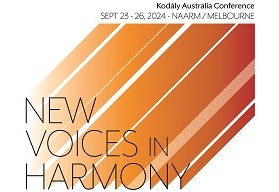Article By Catherine Lange
The following is the second part of a series and focuses on developing a positive learning culture for boys in a mixed middle school choir. For part 1 please Click Here.
It is always exciting at the start of the year to have a sea of fresh faces in choir, eager to sing, learn and be part of a unique team. Some nervous because they are new, others eager because they are the experienced singers in choir. Following on from Part 1, here are a few more ideas, which might help engage your singers and build the choir you want.
Structure of rehearsal
Boys, and some girls like short-term challenging tasks and visual, logical and analytical approaches to learning. They like having the outline of a rehearsal or a plan for the term because they want to know what is expected and the steps they will be taking along the way to achieve success. It gives them a sense of control and understanding that leads to ownership of the learning process. It is importance to design choir learning activities using this approach and Kodály provides a sound base. In your lessons you can:
- write notes on the whiteboard – including the structure and goals of the rehearsal, and any proficiencies you are focusing on (teamwork, creativity)
- establish a rehearsal routine – music in order, pencils out, play a musical game / physical warm-up and then move into a vocal warm-up
- place an emphasis on challenge and frequent changes of activity (singing standing, sitting, whole/part choir singing, moving from verse to chorus, changing pieces, with/without accompaniment, etc)
- keep rehearsals moving at a fast pace with lots of energy eg. warm ups with movement, moving positions, (front row to the back)
- use hand signs to demonstrate pitch, intervals, ascending and descending phrases, etc
- engage them in conversations about the music (form, phrase structure, mood, tempo, lyrics)
- involve them in problem solving (see below).
Repertoire
Through repertoire, we can personalise and connect learning. Boys like to be able to see what they are learning relates to life outside or beyond school and may find it difficult to engage with what appears to be irrelevant subject matter. The repertoire choice is critical and should be of high quality and relevant to them. To support this, I:
- take time to discuss the choice of repertoire, what the intended learning is and why it is important
- encourage them to express any connections (interests and experiences) they have with the repertoire to build on their understanding
- support them to see connections with themselves, previous learning, aspirations
- engage students in discussion and reflection about the meaning of the lyrics, intention of the composer/songwriter
- ask them to choose repertoire (see below)
- ask them to accept a specific challenge (this piece for this performance)
- ask them to think about their musical preferences and the preferences of others.
Student voice/negotiation
Whether working with a single sex or mixed voice choir, listening attentively to student voices within choir and involving them in the learning process is a part of building a positive culture. Giving students opportunities to make decisions about learning in choir builds ownership. Often in rehearsal we are time poor and it seems easier to “call all the shots” from the conductor’s stand. However to truly engage them in the learning process, they need to contribute and be involved in decision making. For example:
- involve them in problem solving – how can we make this sound more dramatic, how can we make an impact on our audience
- share / negotiate roles / responsibility for setting for choir – roll, pencils, music folders
- select/negotiate repertoire – decide on one of three pieces
- ask them to choose and run a physical warm-up,
- involve them in making up words to singing games
- let them select the final song to sing at rehearsals
- let them choose a piece to sing at the next assembly
- promote leadership opportunities through the election of choir leaders
- provide opportunities for formal (survey) and informal feedback about learning in choir.
Have fun this year with your choir!



